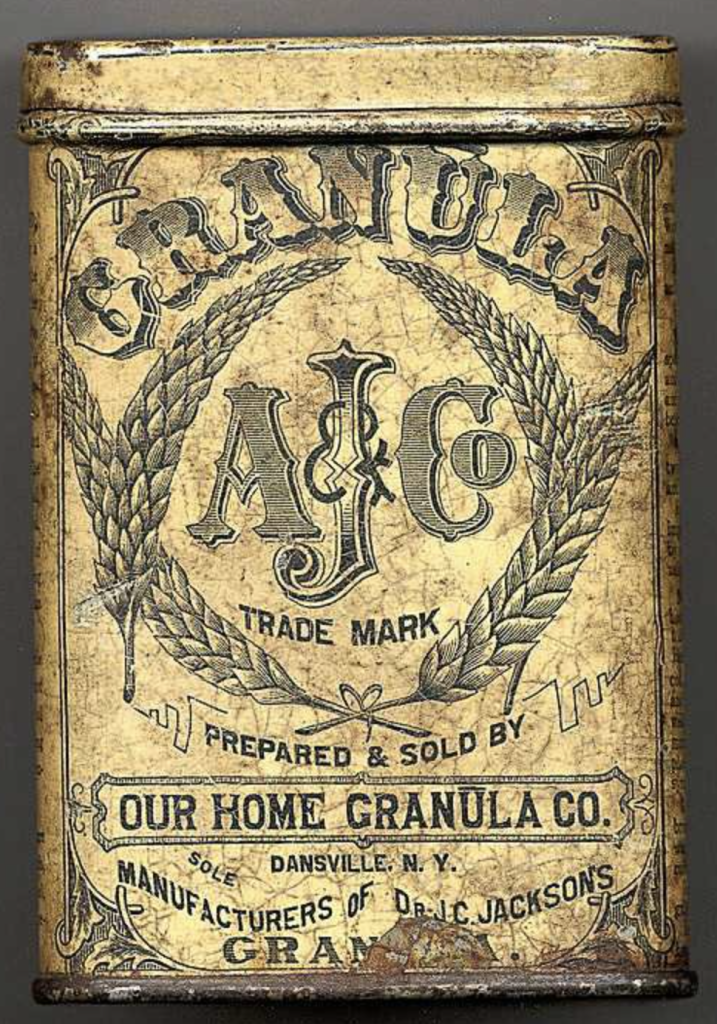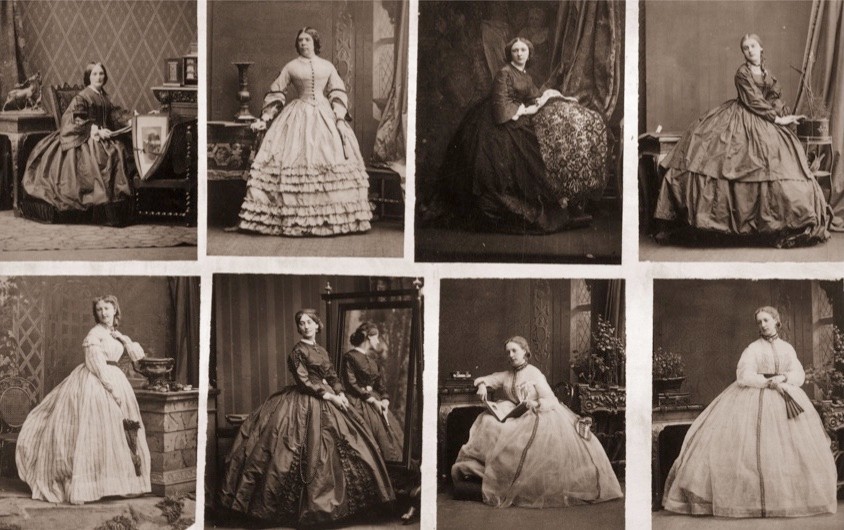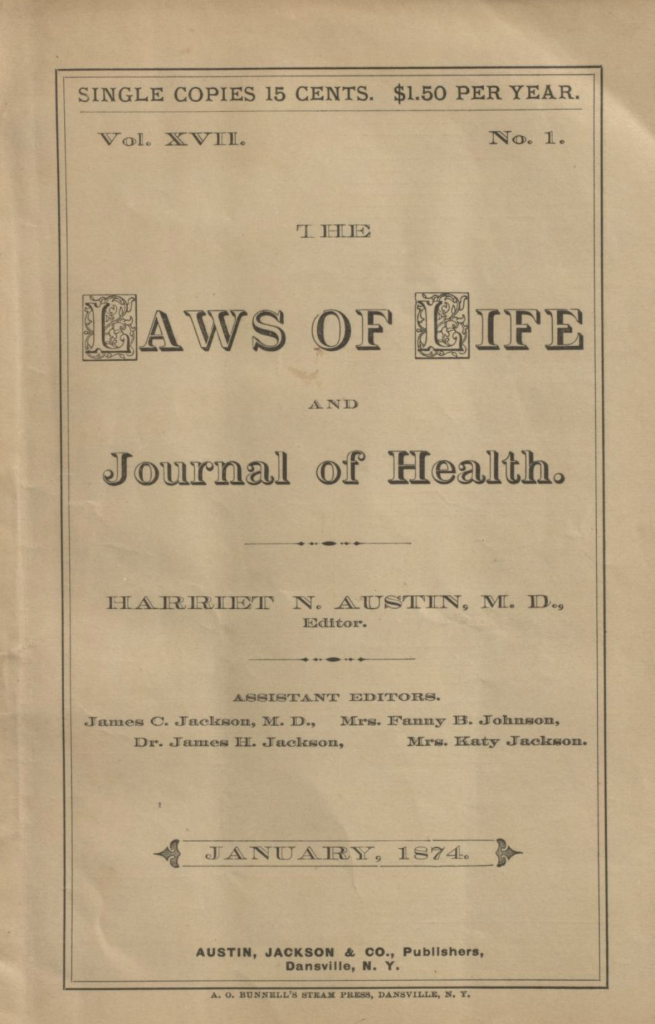(1826 – 1891)
About

Harriet N. Austin was born in Killingly, Connecticut, on August 31st, 1826, to Joseph Austin Jr and Abigail Woodward. She was one of 11 children. She moved to Moravia, NY, with her family. After completing her studies locally, she studied medicine at the Water Cure Institution, founded by Dr. Russell Thacker Trall.
There was strong opposition to women entering the medical profession in the mid-1800s. Women were not permitted to attend medical colleges, and no other schools of “healing” were open to women, putting them at a significant disadvantage.
The Water Cure Institute was the first hydropathic college of medicine, where students studied all the branches of medical practice. They learned to replace the administration of drugs with a new system using water therapeutics. Upon graduation with a medical degree, she became one of the first female physicians in America.
She began her career working with Dr. James Jackson in Dansville, NY, at the Institution, “Our Home on the Hillside.” It became the largest hygienic institute in the world, caring for over 20,000 patients. It was situated on a hillside of 60 acres with spring water flowing from the mountain heights. The comfort and welfare of the sick was the institute’s prime focus, but anyone desiring renewed health or a retreat from the world was afforded every opportunity.

She became the adopted daughter and associate of Dr. James C. Jackson and his wife Lucretia and worked there throughout her life. In addition to water treatments, patients were served simple but highly nutritious meals. No red meat, sugar, coffee, tea, alcohol, or tobacco were served; instead, the emphasis was on fruits, vegetables, and unprocessed grains. Jackson is credited with the invention of the first cold cereal, a graham-flour-derived recipe he named Granula, which was served for breakfast.
In addition to simple food, the institute promoted clean air and water, sunshine, solid sleep, exercise, and hydropathy treatments as needed. Harriet saw the water cure as the basis for a more significant reform movement to help expand women’s societal role and improve their health through hydropathy and dress reform.
As a dress reform supporter, she invented the “American Costume.” Clients at the clinic utilized this mode of dress as less restrictive to foster health. It featured a corset-less mid-length dress or skirt worn over trousers. She designed and made copies of this pattern for women’s use in the home. Although practical, this style of dress never became very popular. Not influenced by other’s opinions, Harriet continued to wear this clothing style until she died.

Clara Barton came to the clinic in 1876 and recuperated under Dr. Austin’s care. Years of nonstop travel as founder of the Red Cross had impacted her health. Making a remarkable recovery, Clara remained in Dansville for ten years. In 1881, she began the first local chapter of the Red Cross. During this time, Harriet and Clara became close friends. Clara was so impressed with Harriet’s work in the medical field that she wrote a tribute to her qualities and professional abilities as a physician.
In 1882, the institute suffered a fire. At this time, Harriet decided to retire. She didn’t have the heart to rebuild, so she sold her interest to her brother, Dr. James H. Jackson. However, she continued to write for the “Laws of Life and Journal of Health,” a magazine she had edited for many years. Leaving behind an incredible legacy, she greatly influenced medical and dress reform.
Dr. Austin died in North Adams, Massachusetts, in 1891 and was buried in the Jackson lot in Greenmount Cemetery.
Dr. Harriet N. Austin was one of the few prominent female doctors of hygiene. She consistently advocated Dr. James Jackson’s health principles and remained congruent with them throughout her life. Harriet firmly believed that women’s clothing was brutal and physically deformed the female body. She broke loose from the style and customs of the day and helped initiate the great revolution in women’s wear. Walking the streets of Danville in slacks, she was one of the boldest women of her time.
Quote:
— Dr. Harriet N. Austin
A woman’s sphere cannot be elevated until she learns and claims her first great right — the right to health. Then will she seek, by a righteous life, to ensure it, and all the blessings which belong to the possession of a sound mind, in a sound body, will become hers.
Life in the Early 1800
In colonial America, a woman administered most medical care at home. However, by the 1820s, male doctors had displaced women, even in midwifery. Women were no longer trusted to manage their well-being, and the old ways of sharing knowledge between women began to wane in popularity, especially in urban areas.

Medicine of the 1800s was a gruesome ordeal. Bloodletting, ignorance of germs and infection, the use of mercury pills and laxatives, and “mainstream medicine” were some of the biggest obstacles to good health. Women were not educated about nutrition, health, or their own body. The state of women’s healthcare indeed left much to be desired.
The practice of medicine was a male monopoly. Medical colleges would not admit female students. Practicing physicians rejected all female applicants wishing to serve an apprenticeship. Examining and licensing boards would not license females.
The establishments started by Mary and Thomas Nichols and Russell Thacker Trall admitted female students and graduated women with the degree of Doctor of Medicine. These female doctors were eagerly received and made excellent names for themselves.
However, as the population moved into unsettled areas of the country, particularly in the South and West, a lack of access to physicians contributed to women once again playing a significant role in providing health care. The Popular Health Movement (1830s –1850s) coincides with a resurgence of women as health practitioners.
Impact of Clothing

Women wore dresses with large, voluminous skirts. Layers of petticoats were used to create this large skirt. These layers were then replaced with the crinoline. The crinoline was an undergarment of steel hoops, creating a cage for skirts to lay over them.
In the 1850s, it was common for women to wear two-piece dresses (a separate bodice and skirt). The weight of the skirts made fast walking taxing, cumbersome, and challenging in many ways. Working alongside an open hearth became a health hazard, as long skirts easily caught fire.
Corsets tightened the waist, squeezed the chest, and made breathing shallow. By the 1830s, steel replaced whalebone, making the corset significantly tighter. This action forced the ribs closer together and narrowed the entire rib cage. Internal organs shifted to accommodate the new shape. The heart was pushed into the chest cavity, and the intestines were forced downward. Rib compression prevented the lungs from fully expanding. This resulted in shortness of breath, fatigue, and, at times, a loss of consciousness. For this reason, carrying smelling salts was a necessity for women.
Corsets also negatively impacted the organs below the ribcage, deformed the ribs into an “S” shape, and misaligned the vertebral spines. For these many reasons, Dr. Austin discarded the regular female attire and wore pants. That was daring in those days, but it took daring to be a Hygienist.

Harriet was an adamant proponent of dress reform, as the day’s fashions were not designed to be healthy. Women who came to the institute needed to use a mode of dress that was less restrictive and would promote health. In response, Harriet created an outfit known as the “American Costume.” It featured a mid-length dress or skirt worn over trousers and did not utilize a corset. She designed and made copies of this pattern so women could create a healthy wardrobe at home.
Many opposed this dress style as being too similar to men’s clothing. Harriet wasn’t too concerned about other’s opinions, and while traveling and lecturing on clothing reform, she continued to wear her designs. She wore this style of clothing all her life.
Teachings
Quote:
“Men, women, and children eat, drink, work, sleep, and dress in modes that defy all nature. When the system yields to their daily outrages, instead of checking themselves to see what may be done to remove ill health, they immediately place themselves in the hands of those who will professionally do their thinking and take over their health care. Hundreds of years of practice have shown the fallacy of this arrangement.”
–HARRIET AUSTIN, M.D.(1826-1891)
During this time, medical treatment in America seems incomprehensible today. Physicians frequently bled patients to “force” the disease “out,” and many died in the process. Blistering was also a widespread healing technique. Houses were unventilated and foul-smelling. Sanitation was neglected; tobacco was used almost universally, and disease was rampant. Water was routinely withheld from the sick, heightening the chances of dying from dehydration. More often than not, the ‘cures’ were worse than the diseases!
Harriet Austin recounts a case of this kind. A person she knew lay in a hotel among strangers and where he was expected to die. “He was tormented with thirst day and night and could not obtain a drop of water. To aggravate his suffering, he constantly heard a running stream of water at the corner of the building. He watched his opportunity and crawled out of bed, down the stairs, and around the house, until he found a large watering trough into which the water was falling. Into this, he managed to get, and there he lay and drank all he wanted. The panic was terrible when he was discovered. He was placed in bed, clothes heaped upon him, and a messenger sent in haste to bring the doctor to see him die. Before he arrived, however, he was sleeping sweetly, and from that moment, he recovered.”
In addition to being deprived of water, patients were denied the benefits of fresh air. Physicians gave strict orders to keep the room and windows closed, and opening and closing doors quickly was a common practice. No fresh air was permitted, even if the room was sweltering or the patient suffered from a high fever. Patients were made to struggle in the confined atmosphere of their sick, putrid chamber. It would be impossible to estimate the number of deaths caused by this lack of fresh air.
Notable Achievements
Medical colleges would not admit female students, so the practice of medicine was a male monopoly. It was a significant achievement for Harriett Austin to attend and graduate medical school and become one of the first females to be awarded a medical license in the country.
Dr. Austin heavily supported the Dress Reform Movement and wrote “The American Costume, or Women’s Right to Good Health.” Her father, James Jackson, founded the National Dress Reform Association, which she supported and helped organize. Austin reveals how water-curists included dress reform among a list of other lifestyle reforms which would improve women’s health and, possibly, women’s social position.
Harriet created an outfit that became known as the “American Costume.” It featured a mid-length skirt worn over trousers and did not utilize a corset. She designed and made copies of this pattern so women could take it home and include it in their wardrobe. Though very practical, it never gained wide popularity.

A Family Health Journal
Harriet became the editor of the publication The Laws of Life, A Family Health Journal, which she edited and wrote for the rest of her life. She focused on all subjects relating to life and health and summarized the knowledge gained by the largest Hygienic Institution in America. The aim was to advocate a healthy lifestyle and to teach how to live, grow, and develop. Articles discussing health and social change, especially women’s clothing reform, were included.
Ever the educator, she wrote Baths and How to Take Them. In this publication, Dr. Austin describes how baths are used as a treatment. She concludes the book by discussing the preparation and various forms of bathing treatments.
Another book she authored was Dr. Harriet N. Austin’s New Method of Treatment of Female Diseases. This book summarized what she observed, learned, and practiced, focusing explicitly on women. Harriet was a fantastic medical doctor, author, editor, and advocate for women’s clothing reform. Her writings left behind a significant legacy and helped influence medical reform.
Learn more from: (Read direct excerpts)
- Trop, Jack. (1961). You Don’t Have to Be Sick. New York: Julian Press.
- Shelton, H. (1968). Health for the Millions. Youngstown, OH. National Health Association.
- Lennon, J., Taylor, S. (1996). The Natural Hygiene Handbook. National Health Association, Youngstown, OH.
- Shelton, H. (1934). The Science and Fine Art of Natural Hygiene – The Hygeientic System: Volume I. National Health Association, Youngstown, OH.
- Graham, S., Trall. R., Shelton, H. (2009). The Greatest Health Discovery. Youngstown, OH. National Health Association.
- Shelton, H. (1968). Natural Hygiene: The Pristine Way of Life Youngstown, OH. National Health Association.
The NHA wishes to remind the readers that nothing in this or other publications is intended to constitute medical treatment or advice. Readers should further be aware that in several areas, previous publications do not reflect the NHA’s current teachings or health approaches.
Our Mission
The mission of the National Health Association is to educate and empower individuals to understand that health results from healthy living. We recognize the integration of all aspects of health: personal, environmental, and social.
We communicate the benefits of a plant-based diet, exercise and rest, a healthy environment, psychological well-being, and, when indicated, fasting.


 SUBSCRIBE TODAY AND NEVER MISS AN UPDATE
SUBSCRIBE TODAY AND NEVER MISS AN UPDATE